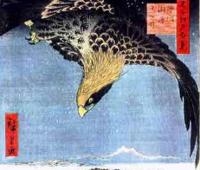
The messenger
by Mrs. Daniela Schifano
In the colour of an uncertain dawn, suspended between moon and sun, I imagine a motionless eagle watching its kingdom: strong in its extraordinary sight, strutting and made even more regal by a blowing wind which lifts its feathers, it eyes every nook and cranny in search of unwary prey, while the sky calls to ride the clouds. Far away, clear and unpolluted, the peak of Fuji dominates the scene : it is a world of serenity that the sacred mountain inspires, a steady landmark even in stormy times for a mankind immersed in the usual everyday life.
The raptor seems to perceive the sacred of the mountain in a genuine relationship with beauty in fact the eagle itself is a symbol of God’s will and power in history and time. Massive, majestic proud, capable of reaching dizzy heights in a short time and of diving with unprecedented speed and mastery towards sheer cliffs, as if it wanted to demonstrate its superb authority, it is capable of moving in the sky without a fluttering of a wings, to see tiny things from very great distance.
By the land of Kai and the wave-washed land of Suruga
rises up
the peak of Fuji.Heaven's clouds
Halt in their course, and
Winging birds, as well
Will not fly atop it.Its burning fire is quenched with snow, and
falling snow dissolves in fire.I cannot speak, I cannot find a name to give
For the dark riddle of this awesome living god.
(Mushimaro, Seventh century d.C.)

Mount Fuji is a unique mountain: in height it is the tallest of all bordering lands; by location it is isolated and unchallenged in the surrounding landscape; for visibility it can be glimpsed from the very distant regions of continental mainland; by such a pure and elegant line it is a perfect cone; by typology it is an active volcano, therefore alive.
Sacred Mountain to Shinto: Yama no Kami, the home of spirits, ancestral gods of the mountain, then personified in the divinity of Konohana Sakuya, a descendant of Izanagi and Izanami, the primordial divine couple generating the archipelago of islands.
Sacred Mountain to Buddhism : a religious simbol, connected with life and death. In Nihon ryoiki (eighth or ninth century) is reported how En no Shokaku, a Buddhist hermit, who was accused of witchcraft during his exile on the island oh Oshima, ascended the sacred mountain to meditate at night.
 |
Alighting or flying, the eagle enchants man, both in imagination and in the unconscious: a deep powerful magnetic gaze, a proud upright stance, that bill and those claws which only a superb predator owns, magic wings capable of amazing flights. Its secrets are strength, self-confidence, beauty, art of flight, harmony quickness of reflex, the magical transformation of predation.
From the flashing up and down of an eagle descending to claw its prey to the swift flash of lightning: according to an ancient legend, the eagle is the only bird which a thunderbolt can not hurt. Hence its relevance to the upper regions of air, to the sun and to the thunderbolt make it a symbol of divine will and power, while its high, safe, straight, fast flight makes it gods’ messenger, from Zeus to Christian iconography, which often represents angels with eagle wings. |
|
|
|
|
This is what the eagle meant to man in time and among different peoples however I still want to imagine it with its unmistakable great silhouette come out of horizons of cliffs and canyons and plane or circle with large wings. I watch a stone and see an eagle, in the play of imagination that gives space to soul and feelings to drift to an inner communication that is free like a gentle breeze flowing from a hardly traced shape to a not only mental interpretation. Beyond words, explanations, reasons, this is, for me, the magic of suiseki.
|
|
| Beyond words, explanations, reasons, this is, for me, the magic of suiseki. | |
| (Published in the January 2009 issue of "Bonsai & Suiseki magazine")
|
|

